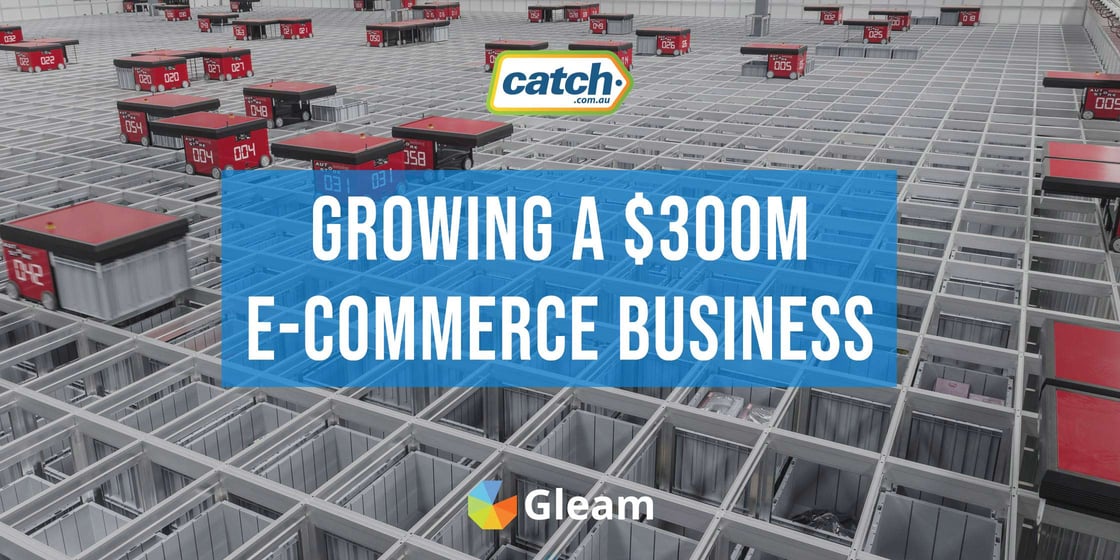Tactics Used By Catch
Whether it’s the latest iPhone X, Christmas presents or some new clothes; we all love the adrenaline rush of shopping online. There’s just something about being able to get your favourite products at cheaper prices than the high street, with the added convenience of not having to leave the house.
The E-commerce industry in Australia is booming, in 2017 we’re expecting as a nation to spend over 10Bn shopping for our favourite products online. Amazon is planning to launch in Australia sometime in 2018, and Australia Post has released stats saying that online shipments have increased from 11% to 15% of their total volume in the last 12 months alone.
With total online sales in the billions, our love for online shopping has propelled Australia’s E-commerce market into a global playing field.
This graph below shows that Australia’s online E-commerce sales are expected to increase by 56% over the next 5 years.
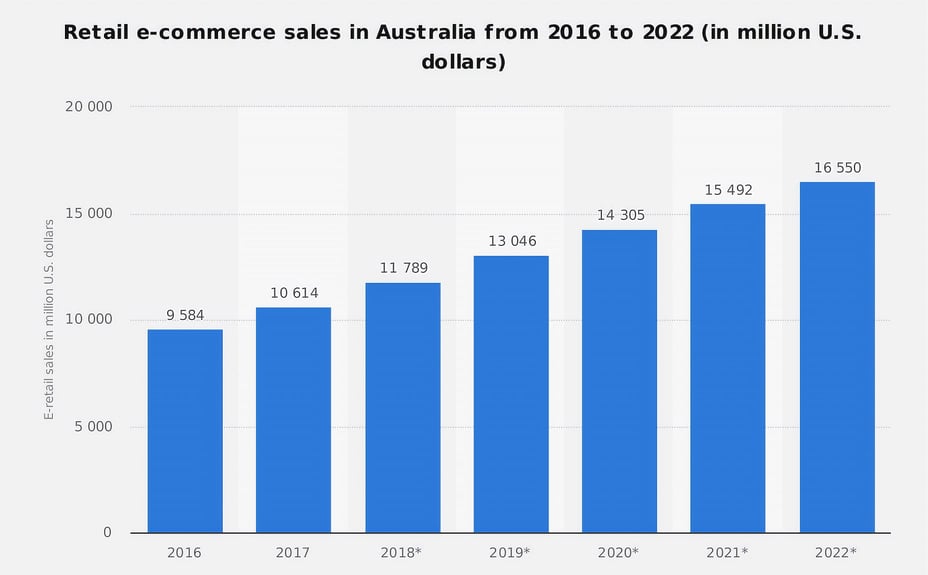
In Australia, the E-commerce space is still very young. We have a landscape that was once dominated by incumbent brick and mortar stores like Myer, David Jones & JB Hi-Fi.
But these stores failed to transition online fast enough and provide an E-commerce experience that we’re used to elsewhere in the world.
Due to this E-commerce disconnect, you will find that many Australians look overseas to find a bargain. We’re prolific users of eBay and Amazon due to their cheap prices and often free shipping.
But there has been one local merchant that has weathered the E-commerce storm and come out ahead of many of the others that are struggling in the space.
In this post, we’ll be looking at the Catch Group (formerly Catch of the Day) – a $300m+ local behemoth that has found their footing nicely in the Australian marketplace by providing customers exactly what they want.
In this post, we’ll be breaking down some of the key growth strategies that Catch are using to grow their business.
So, whether you’re in the initial stages of starting an E-commerce store or already trying to take yours to the next level, read on and hopefully you’ll be able to apply some of the tactics we’re about to jump into.
Introduction to Catch
Catch of the Day was started by Gabby and Hezi Leibovich in 2006 as one of Australia’s first “daily deal” websites.

The idea was simple, they would get a large amount of stock of a particular item then put it up on the Catch of the Day website at an incredible price in limited amounts. The model itself was inspired by a number of similar sites in the US such as Woot.
This combination of price and scarcity was an instant hit with Australian shoppers which propelled the site to popularity.
This model has proven successful for the Lebovitch brothers, they won numerous business awards, grew sales to $250m and have one of the highest trafficked websites in Australia.

But it hasn’t always been sunshine and roses for Catch of the Day, they have had a number of issues to deal with along the way.
- In 2014 they suffered a data breach which spanned historically 3 years.
- In 2012 Catch of the Day acquired Vinomofo only to sell it back to the founders 3 years later (at a much lower price than it was purchased for).
- In 2015 Eat Now merged with Menulog (a business which Catch is a large shareholder in)
- They have been involved in a number of Trademark disputes including registering Groupon as a trademark before Groupon entered Australia, then getting into a dispute with Target over the Tar-Jay parody Trademark.
- They survived the consolidation of daily deals websites in Australia through smart acquisitions (more on this later).
In June 2017 Catch of the Day rebranded to Catch and pivoted their model slightly towards a marketplace selling brands and various other product categories. One of the main reasons for the change was to be more competitive and prepare for Amazon’s launch in Australia, it was also to combat the eventual burn-out and downtick of the daily deal industry caused by Groupon and other sites.
In order to achieve this rebrand The Catch Group had to make some strategic acquisitions and investments to broaden their footprint:
- Scoopon: Was launched by Catch in 2010 to go head to head with Groupon.
- MumGo: Catch acquired MumGo in 2013 to increase their presence in the female fashion sector
- GroceryRun: Was launched by Catch in 2011 as a way for Australians to buy groceries online
- Bon Voyage: Was launched in 2017 in partnership with Jennifer Hawkins to appeal to the Travel Experience market
- Pumpkin Patch: Catch bought the remaining IP of collapsed NZ fashion brand for ~$2m AUD (And now feature them heavily)
- Brands Exclusive and TheHome: Catch acquired Brands Exclusive and TheHome in exchange for Bon Voyage and Scoopon Travel as a result of an asset swap with Lux Group to strengthen their market leader position.
The rebrand has now seen Catch become a marketplace that spans a wide range of consumer interests. The beauty is that everything is now consolidated into a single experience across all the brands too (more on this later).
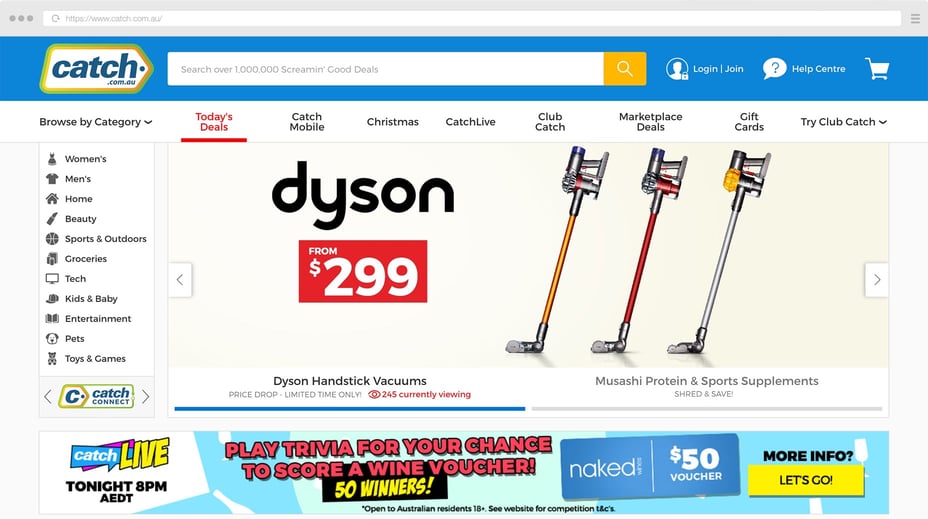
So let’s dive in and look at some of the strategies The Catch Group are using to grow their sales:
Organic Search
A solid SEO strategy is a must for any E-commerce website. You need to lay the SEO foundations for your product and category pages right from the start.
Rebranding can also be a scary exercise, when you move from one domain to another it can often be a worry that you lose your organic rankings.
However Catch handled this perfectly by properly 301 redirecting all pages to their appropriate page on the new domain:
https://www.catchoftheday.com.au/brand/garmin/ GET /brand/garmin/ HTTP/1.1 Host: www.catchoftheday.com.au User-Agent: curl/7.54.0 Accept: */* HTTP/1.1 301 Moved Permanently Location: https://www.catch.com.au/brand/garmin/ Content-Length: 0 Connection: keep-alive
And as a result you can see that they maintained their Organic exposed to roughly the same number of keywords:
Before Migration
Before the migration they were ranking across ~100k total keywords in Australia:

After Migration to Catch.com.au
After the migration, they jumped 20% in total keywords, then levelled off again around the 100k mark in September.
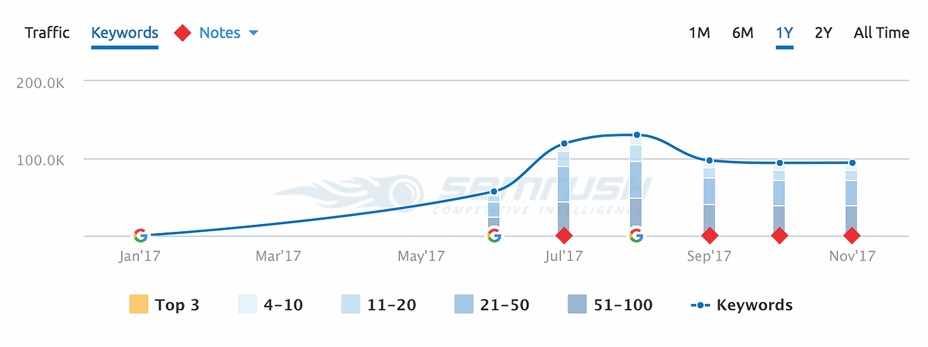
Catch has a typical structure that helps with SEO:
- Homepage
-- Brand (i.e. Kenwood, Pumpkin Patch or Nike)
-- Category (i.e. Mens, Women's or Beauty)
--- Event (Sales or Deals within that Category)
--- Sub Category (Sunglasses)
---- Department (Men's Sunglasses or Women's Sunglasses)
----- Product Page (Anne Klein Women's Sunglasses)
-- Event (Events can also be promoted to the Homepage)
Brand Pages
If you look at a breakdown of the top keywords that Catch receives traffic for, the majority are brand related.
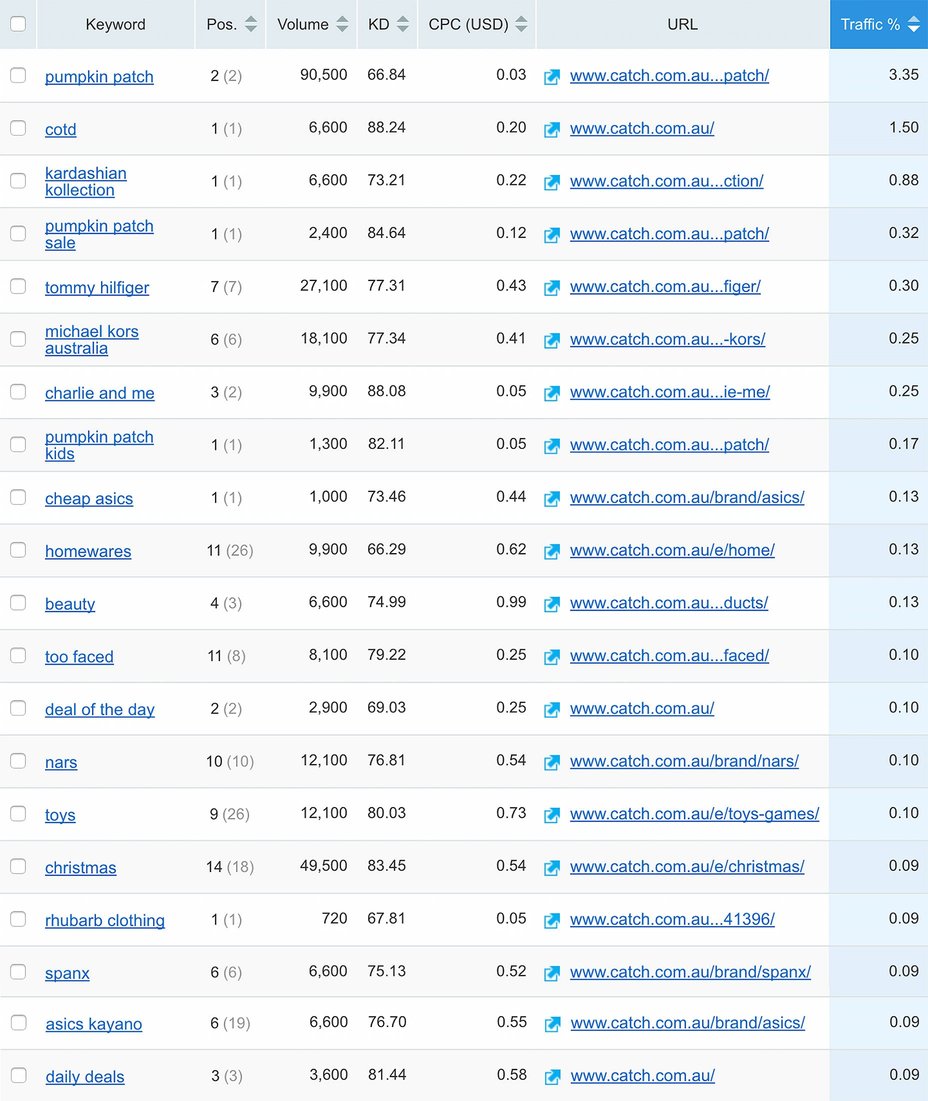
Brand pages are often the most lucrative pages on an E-commerce site from an ROI perspective. Imagine that you have a consumer, that already has an affinity to a specific brand searching for the best price. Quite often these users are already in the transactional phase of the shopping cycle.
Compare this with a generic keyword like clothing, the user is in the research phase of the shopping cycle (and these keywords are often hyper-competitive).

Catch does use a rather plain title tag blanket strategy for all of their brand pages, but it does seem to work relatively well:

Event Pages
The Event pages on Catch are for more transient content (sales or daily deals) that might not be a permanent fixture or always in stock.
They make up a large portion of the Catch website, being prominently featured on the homepage and also inside top level categories.
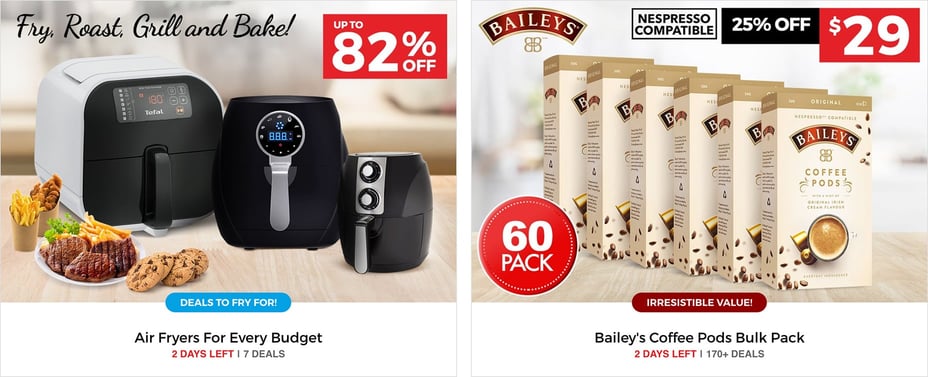
However, many of these pages still rank extremely well in the search engines for specific keywords.

Or seasonal pages that aggregate products for specific times of the year (Easter, Christmas or Fathers Day etc)

Product Pages
Products can live inside Categories or Events, each with their own product page URL (which I feel could lead to some duplicate content issues).

Catch does appear to get consistently outranked on many of these pages by Amazon, eBay and some of the other shopping aggregators who perhaps have more permanent pages for these products.
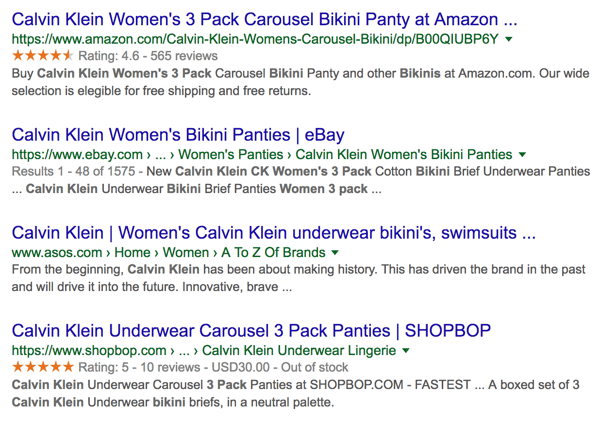
There’s a few issues with these product pages, firstly Catch approaches the Title tags once again in a formulaic manner.

But they waste 15 characters of prime keyword realestate by including their Brand at the start of the title tag instead of at the end.
I would be more inclined to do something like:
<title>Calvin Klein Women's Bikini 3-Pack - Black/Grey/White | Catch.com.au</title>
They also create unique URL’s for products that are inside an Event, these URL’s are new and often never really get the chance to rank since they have a limited lifespan on the site.
https://www.catch.com.au/event/calvin-klein-womens-underwear-loungewear-67161/product/calvin-klein-women-s-bikini-3-pack-black-grey-white-413002/
There’s also the issue of some of these URL’s being duplicated across the Catch network of sites:

Paid Advertising
Catch invest heavily in paid advertising to supplement the huge amounts of brand and organic traffic they already get.
Google Ads / SEM
There’s a number of reasons why this is a good strategy:
- There’s high ROI on specific keywords
- Keywords that aren’t high ROI can expose a user to your brand which leads to future or repeat purchases
- Paid ads can be used to test ideas before you commit to them fully
- You can supplement poor performance or rankings elsewhere with a higher ad spend
- You can target high volume brand keywords that you’d never have a chance of ranking for
- You can keep competitors away from your own branded terms
We can see that Catch has increased their overall SEM spend by 300% in the last 3 months.

If we look at the top keywords they spend money on there’s a pattern of bidding on very generic keywords and brand names.
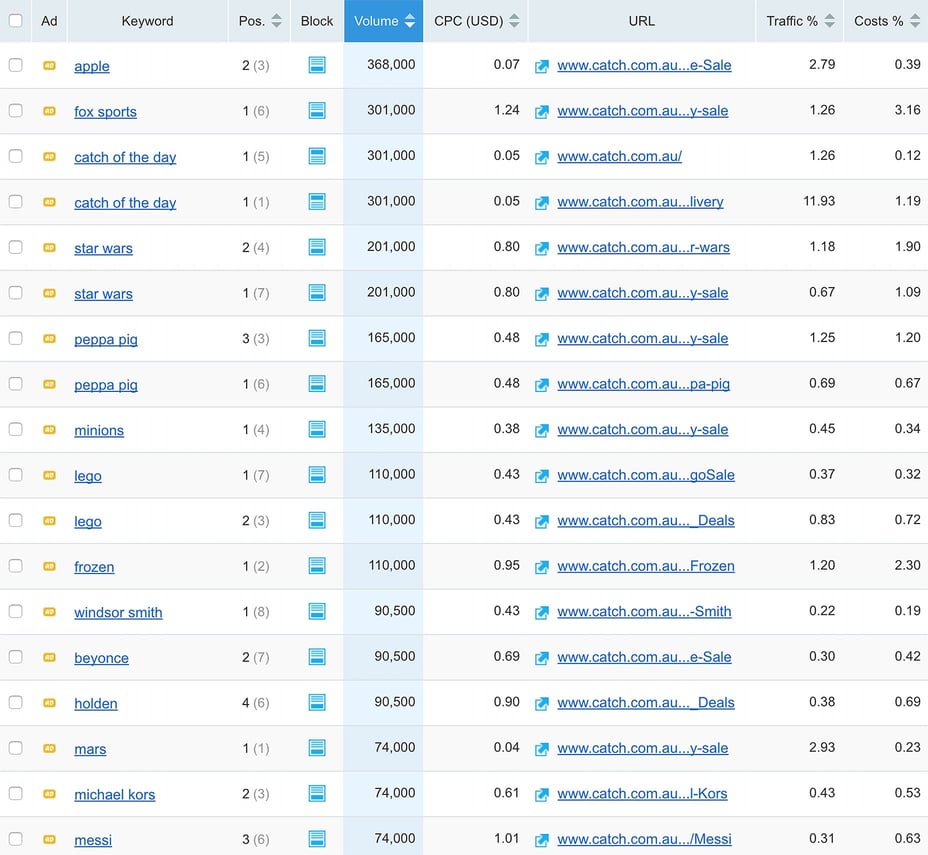
They supplement this strategy by landing users on very targeted landing pages for each keyword, sorted by product popularity.
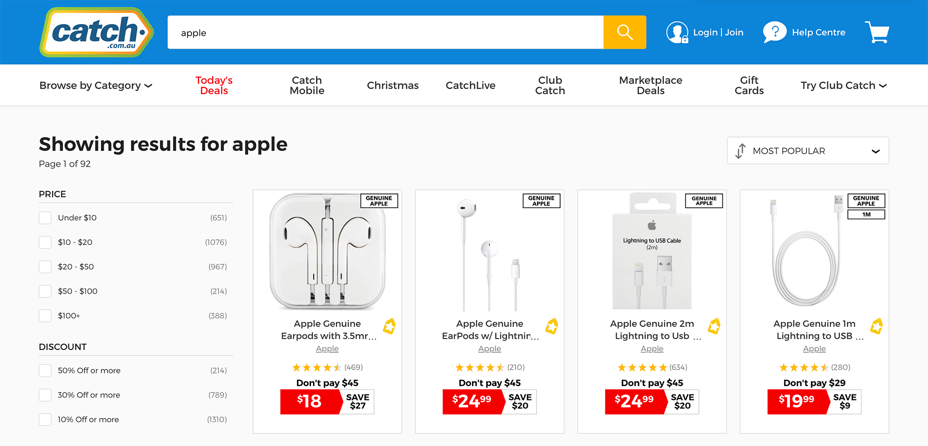
They use a number of different ad formats:
Standard Search Ads
These ads are used to prominently feature for specific targeted search results, notice how they also link their reviews to provide social proof (which increases CTR).

Shopping Ads
One tactic that Catch uses very heavily is extremely specific product targeted shopping ads.
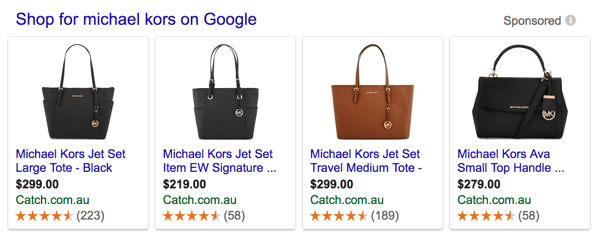
Retargeting
Catch uses Criteo to retarget users with ads. The magic here is that they don’t trigger the retargeting pixel until you’ve added something to your shopping cart – then abandoned the site.

These ads act as a reminder to come back and complete your purchase if you’ve left the site. Catch also runs these product specific ads directly in your Facebook News Feed:
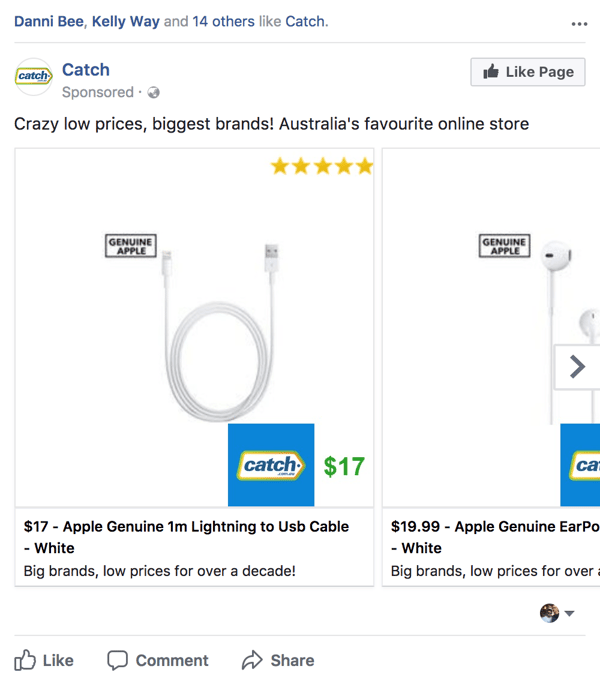
The beauty of these ads is that they show the products you’ve recently either added to your cart or browsed on the site.
Clicking each section of the ad also takes you directly back to the specific product landing page.
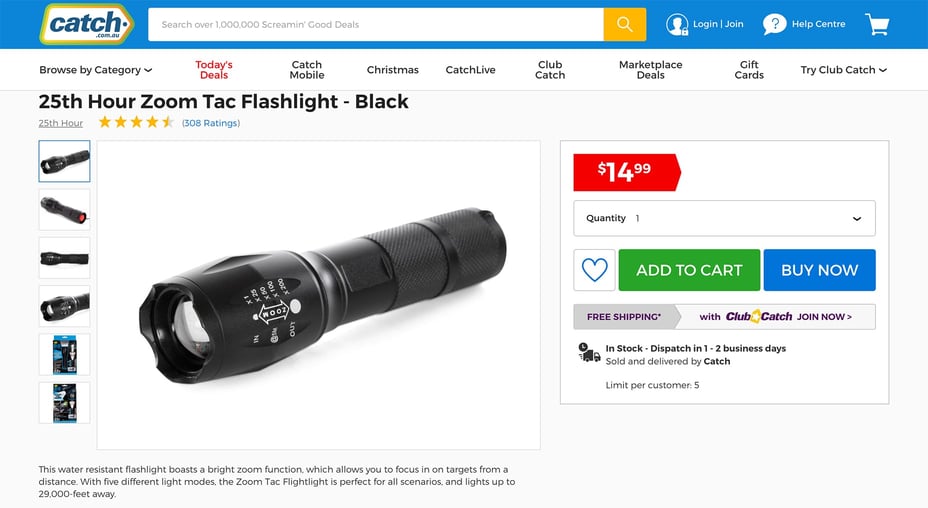
Email Marketing
Email Marketing is Catch’s bread and butter and a channel they have dominated for many years. In the early days, their customers were used to getting 3-4 emails per day due to the daily deal nature of the site.
And this is no exaggeration, here’s a quick look at my inbox from the last week:
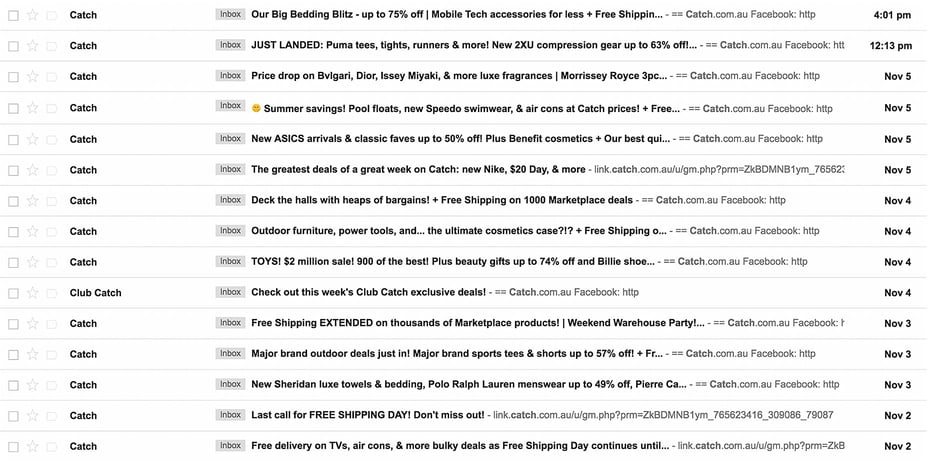
Catch sends 3 emails per day, always around the same time:
- 9am: The early morning email, to get you as you’re waking up or getting into the office
- 2pm: The afternoon email, something to read as you’re winding down for the afternoon
- 7pm: The evening email, something to look at in the evenings after dinner or putting kids to bed, this is an interesting one for me – as quite often no-one really emails at time of day (therefore you get more 👀)
Sale Emails
This is a typical email that Catch will send out almost every day. It takes you through the top Events for that day and also does some cross-promotion for Scoopon.
These emails don’t appear to be personalised in any way, just merely getting sent out as new sales or events are added.
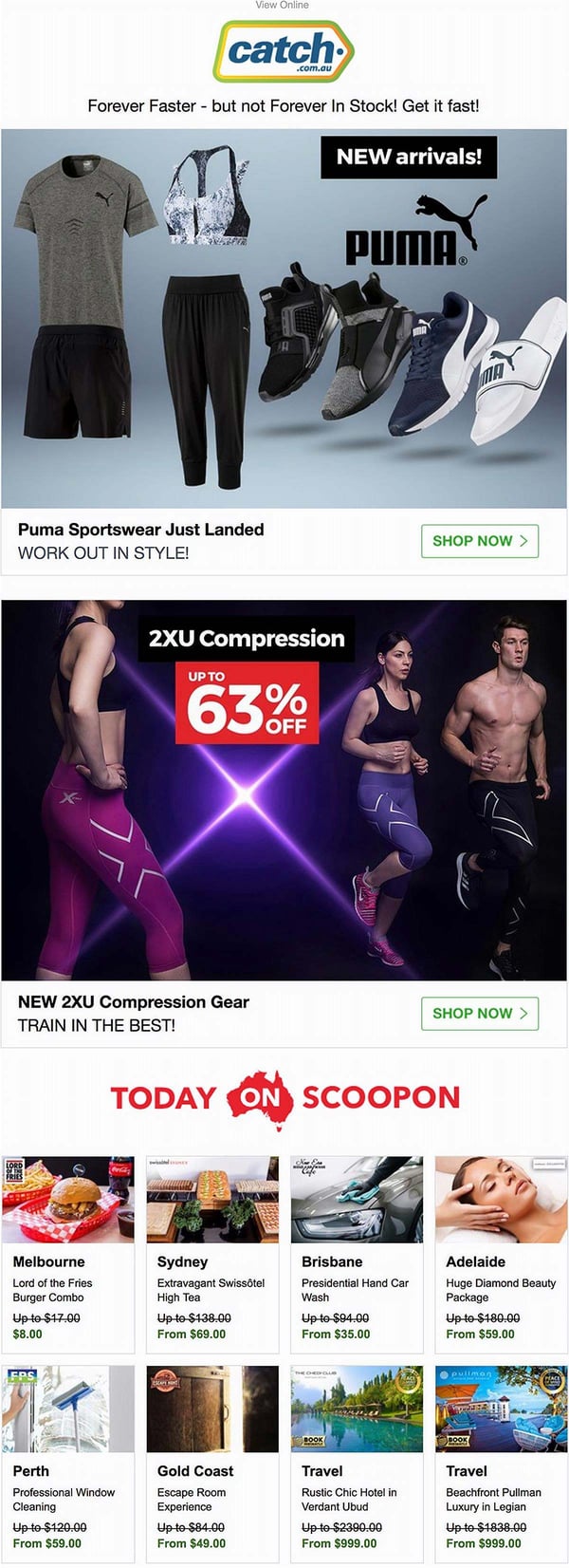
Their email subject lines are specific and straightforward, specifying the product or brand sale and discounts.

Daily Event Emails
Whilst Sale emails are focused on specific products or brands, Catch also likes to piggyback off calendar events and specific days of the year.
They will typically send emails focused on:
- Global Holidays: Fathers Day, Mother’s Day and Valentine’s Day
- National Holidays: Click Frenzy, Australia Day and Spring Carnival
- Sales: VIP Specials, Brand Specific Sales (i.e. LEGO sale), Demographic Specific Sales (Gifts for x)
- Discounts: Cart Discounts (i.e. 10% off), Pricepoint Specific (i.e. $10 Day)
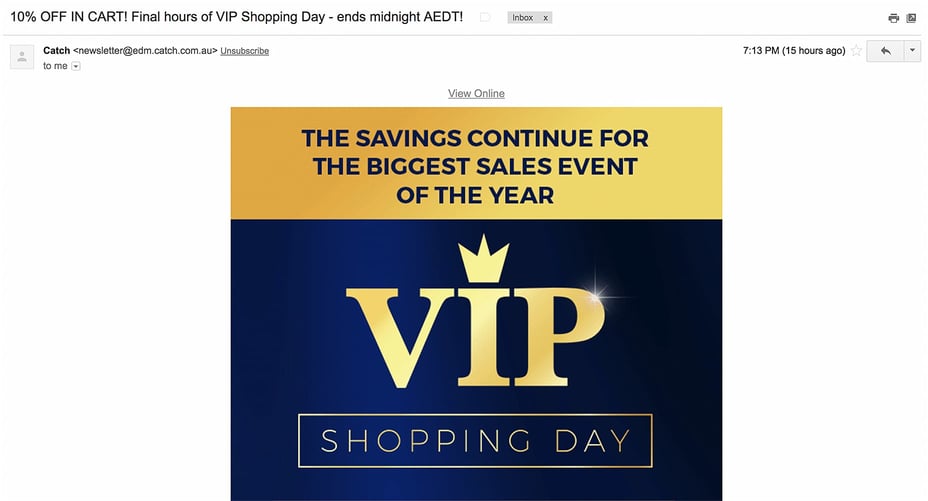
Abandoned Cart Emails
If you’ve ever run an E-Commerce business then you know that every customer that leaves your site without purchasing is a lost opportunity.
We’ve already seen earlier that Catch attempts to recover this revenue by using Retargeting ads to encourage you to complete the purchase. The next step up from this is to use cart recovery emails to send the users a reminder directly to their inbox.
This strategy is vastly superior to retargeting ads since you can reliably make your way into every user’s inbox (without waiting for them to see an ad). Naturally, you need the user’s email first for this strategy.
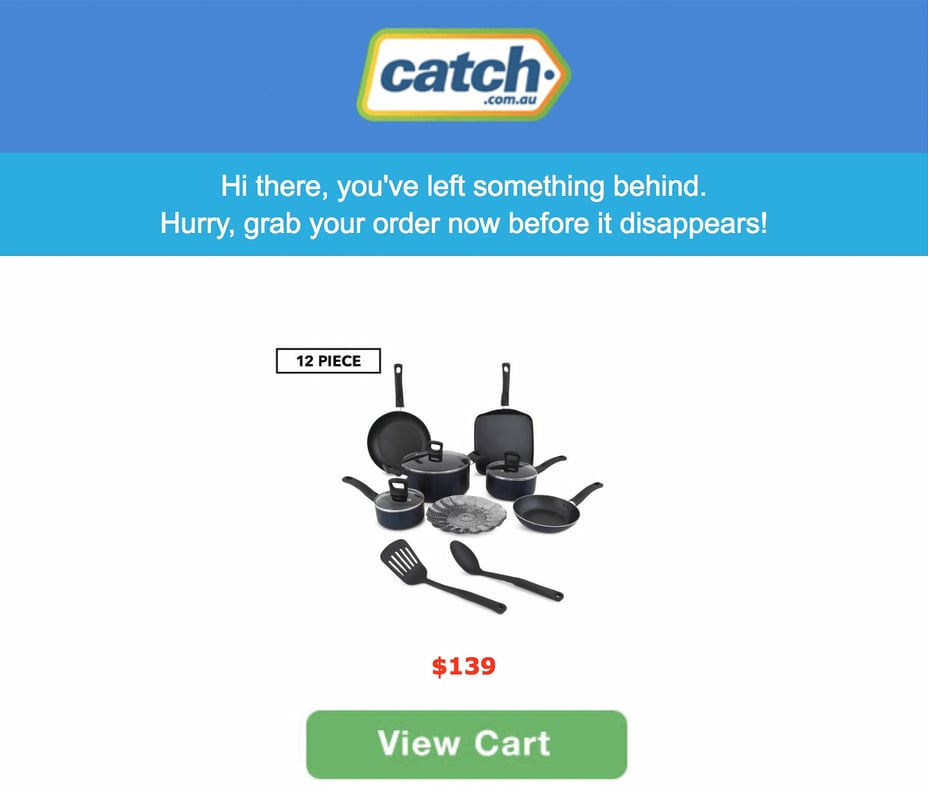
Catch sends out these emails usually in a few hours after leaving the site with the subject line: “Psst… you’ve left something behind”. One of the ways Catch persuades the customer to come back and complete the purchase is through urgency in the title.
Email obviously plays a huge part in Catch’s engagement strategy, it allows them to continue to drive ongoing revenue and value from users.
So let’s move on and see how Catch drives more sales through their website…
E-Commerce Optimisation
Just driving traffic to your site isn’t quite enough these days, you need to do as much as you can to ensure you offer a clean, fast and enjoyable experience for your customers.
Catch has a fairly flat architecture with a relatively minimal look. This makes it easy and fast for customers for to navigate through sales, events and products with the ultimate goal of making that purchase.
The site has a fast load time on both desktop and mobile, but room for a good amount of improvement if you look at a tool like Google’s PageSpeed Insights.
Site Navigation & Search
Catch makes it easy to navigate the site and find products by providing good overarching structure and categorisation.
We mentioned earlier in the guide about how these categories can also assist with SEO. Just remember that it’s important to build the side for the user first, and not to always have SEO at the front of your mind. Catch meets decent middle ground in this respect, it’s not overly optimised but performs well in both search and for users too.
Products are further categorised based on specific items found on the top bar after clicking on Browse by Category and once you over a category, it pops out with further subcategories.
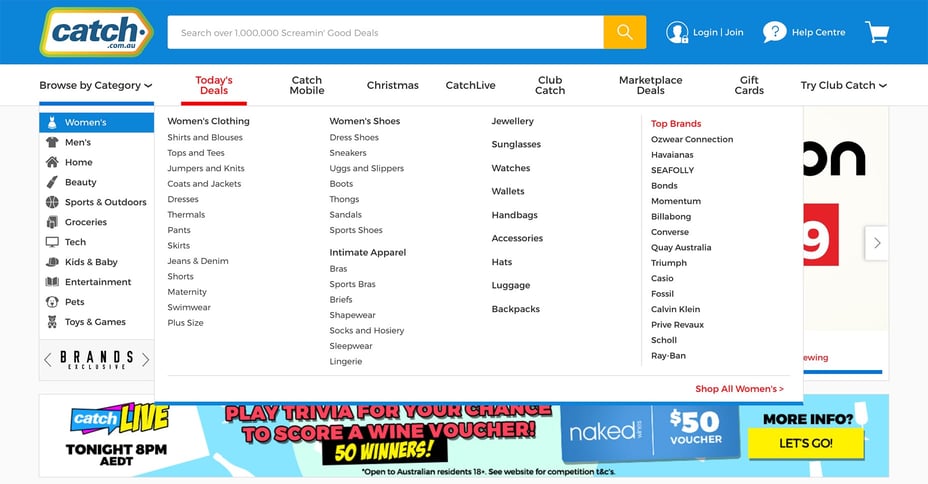
But what about when you can’t find what you’re looking for? A decent search engine is often something that many E-Commerce websites consider, but this is a feature that Catch seems to nail extremely well.
Their search page is:
- Relevant to my search
- Sorts products by popularity
- Many filtering options (Department, Price, Rating etc)
- Can sort by products with the biggest saving

They also have internal links to their other sites, such as Scoopon, Grocery Run, Mumgo and Bon Voyage to allow easy navigation across the entire portfolio.

Email Capture
Catch puts a huge importance on capturing email addresses so they can market to you. They have a very simple floating email capture form that shows to all non-logged in users.
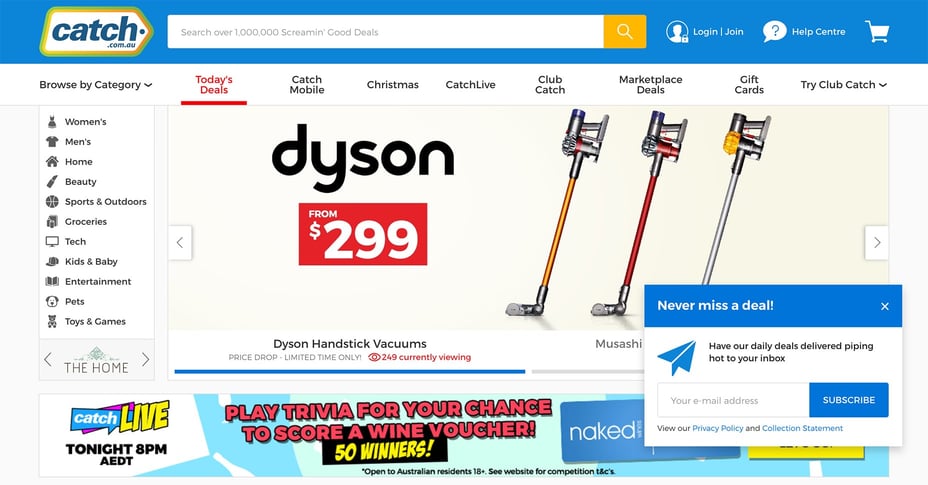
You can make a form like this using our Capture app.
Push Notifications
Some users don’t like to give up their email address, so Push Notifications offer an easier way to notify users of new deals via their browser.

Customer Support
Catch puts a lot of effort into making the whole shopping process a positive experience, which can be difficult due to them being a 3rd party between many of the marketplace transactions.
They have a whole page dedicated to answering questions about shipping, delivery and product queries. It’s easily accessible on the top right of the page beside the checkout icon.
They also have a live chat support widget at the bottom of the site to answer questions more quickly. However, this only seems to show rarely based on some select rules (which I imagine is to prevent their support team getting overrun with questions)
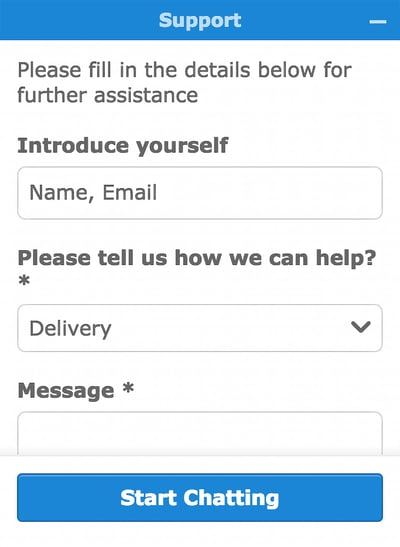
Another nice touch is the email they send when you make a purchase, which allows you to rate the experience with the 3rd party seller. This helps them ensure a consistent and high level of quality across their sellers.

Page Layout
All deal and events sections in Catch’s website are presented in a 2×2 grid format. They put a lot of time and effort into their images, trying to show as much of the products on offer as possible (to entice more people to view that deal).
They also highlight the percentage savings of certain deals to let customers know what sort of discount to expect.

They also create a sense of urgency on certain listings through countdown timers, prompting customers to purchase items quickly before time runs out.
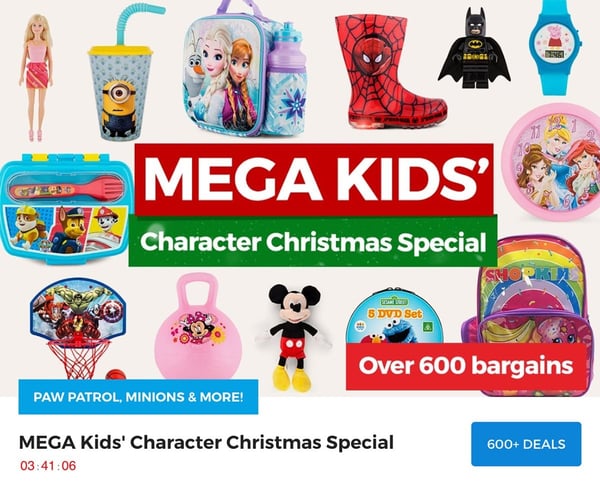
Product Pages
Product pages are perhaps the most important page on an E-Commerce website. We’re going to break down some of the things that Catch does to drive more sales.
The URL we’re looking at here is the Spiderman Bowling Set:
https://www.catch.com.au/product/spider-man-bowling-set-43042/
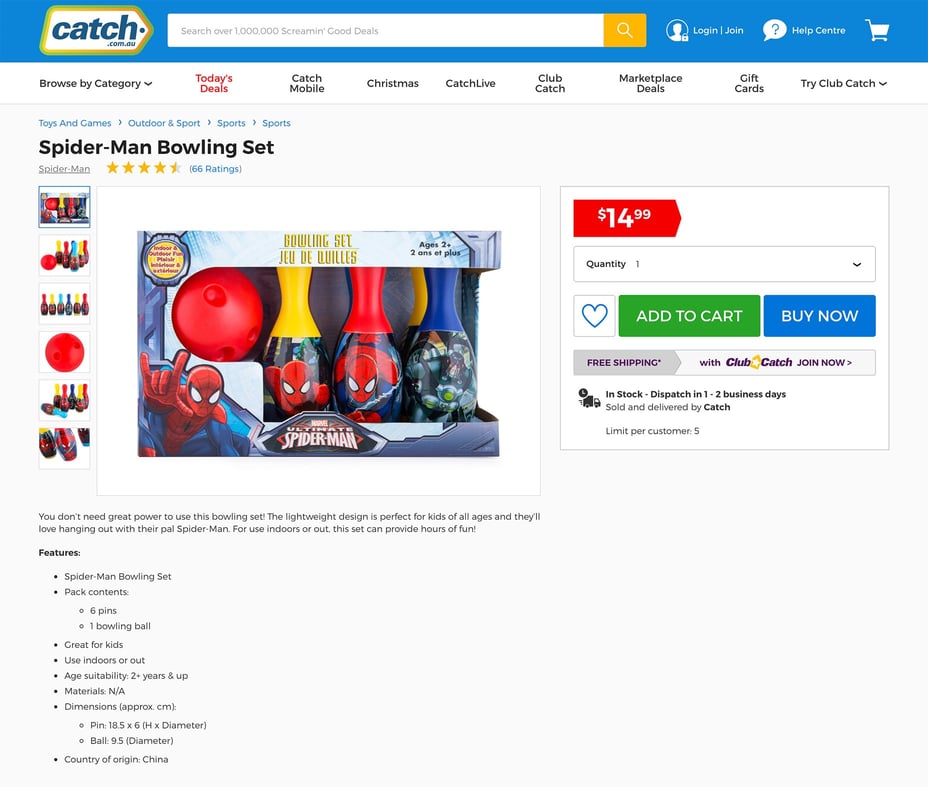
Each product page can be broken down into a some basic parts:
- High quality product images in a slideshow format that can be viewed full screen
- Clearly highlights the price and discounts (Don’t pay x)

- Big green Add to Cart button
- Cart follows user down the page
- Add products to a Wishlist to purchase later
- Heavily promoting free shipping via Club Catch
- Links to any size charts for clothing
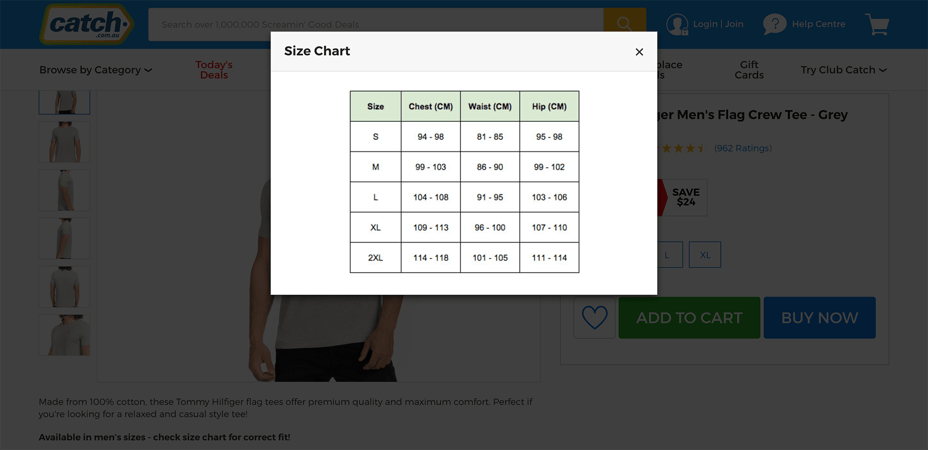
Much of the implementation that we see on Catch draws a lot of inspiration from Amazon. One of the big features that Amazon really nails well is product recommendations. This is a feature that Catch also utilises heavily to drive incremental revenue from users browsing specific products or categories.

Catch also leverages social proof on product pages via embedded product reviews from past purchases. On product pages, customers are able to add ratings and write reviews on the product after purchase.
Ratings are also one of the filters options on product search pages, allowing customers to only show products in search results based on star rating.
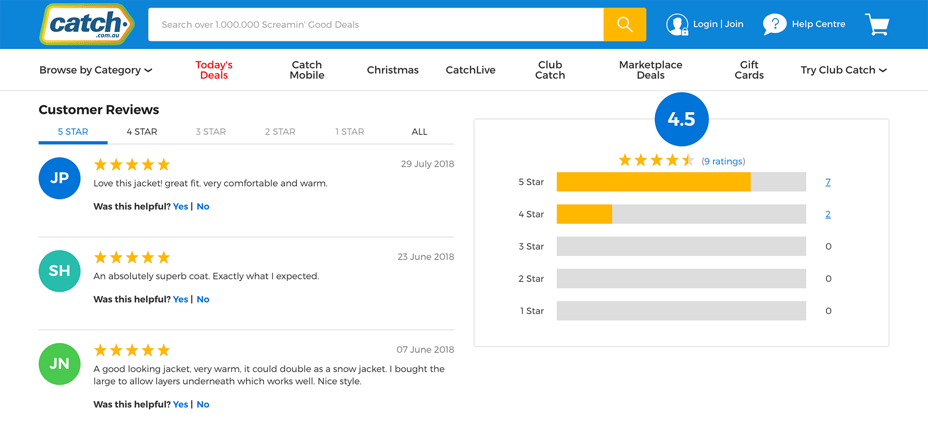
With the correct Schema tags you can also push this rating through to search engines to increase clickthrough rates on specific targeted product searches.
<div class="rating rated stars-n-link" itemprop="aggregateRating" itemscope itemtype="http://schema.org/AggregateRating"> <div class="hidden"> <span itemprop="ratingValue">4.5</span> <span itemprop="reviewCount">23</span> </div>

Catch also encourages you to review recently purchased products via email and further prompts you next time you login to your account.
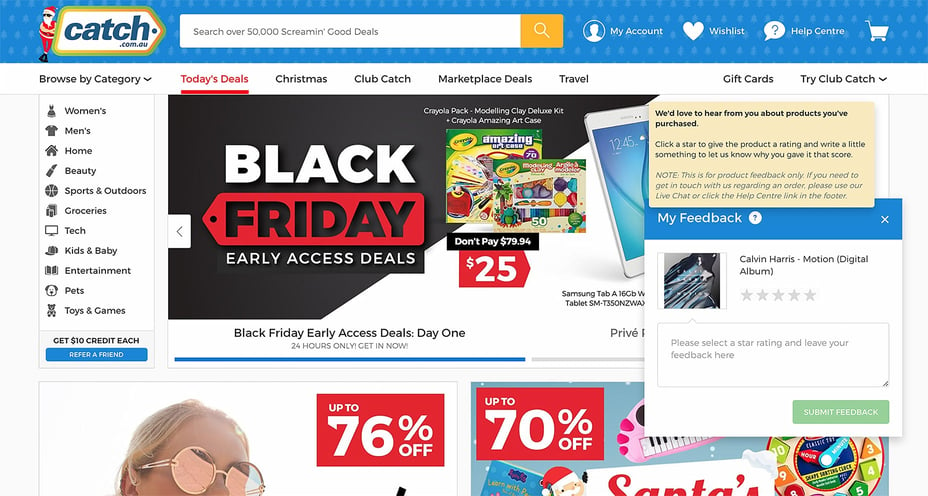
Main Signup Flow
Catch offers quite a few signup flows depending on where you are in the buying process.
Signing up for a Catch account is quick and easy, without requiring much information. They put a big importance on logging in with your Facebook or Google account to reduce friction.
All that’s required is an email address, password and if you have one, a referral code.

The referral code is interesting, this gets pre-filled if a user signs up to Catch using your unique referral link (which is generated on the Refer-a-friend section in the backend.
https://catch.com.au/register?ref=8wkylpw2
If someone uses your link, they’ll get $10 store credit after they purchase something for the first time and you’ll also get $10 credit too.
This entices customers to spread Catch’s site and encourage friends to sign up via your link.
Guest Checkout
Catch understands the importance of not forcing signups, especially in the shopping cart.
To combat this they delay the signup by allowing you to fill your cart with products, then they ask you to signup just as you’re about to purchase.
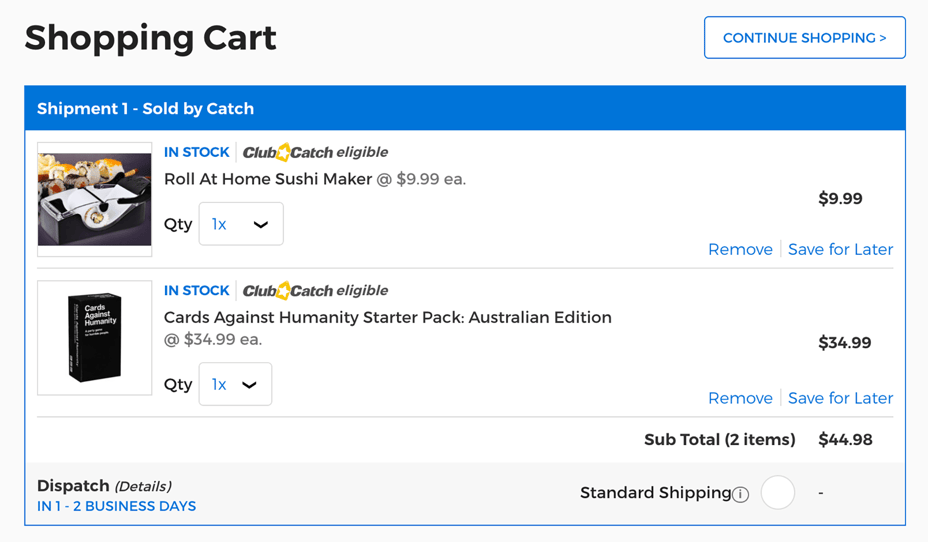
Modal Signup
Then in some scenarios where they want you to be able to login or signup and go back to the previous page you were browsing they use a modal.
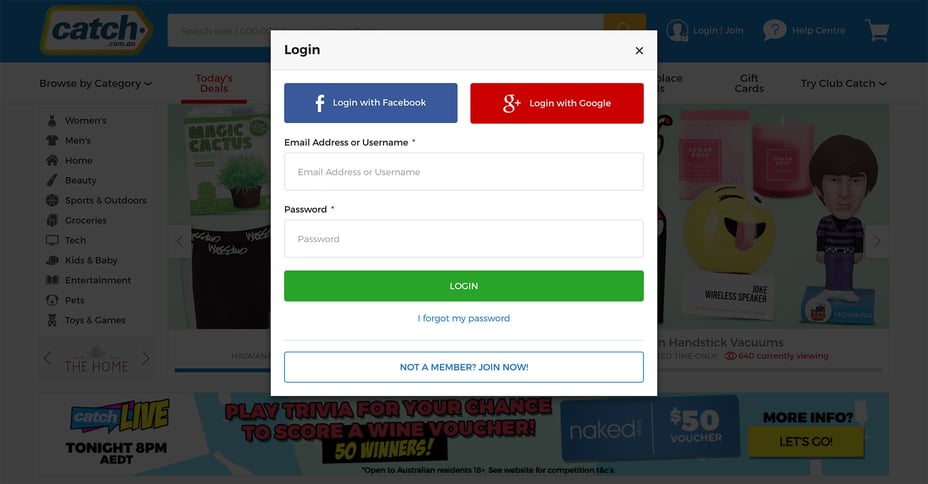
This method has the advantage of allowing existing customers to login easily without losing their position on the site (i.e if they were browsing a particular product or sale).
Club Catch (i.e. Amazon Prime)
Club Catch is a paid membership program that was launched in 2015 and offers similar benefits to Amazon Prime.
It offers:
- Free delivery on $50+ orders
- Club Catch EXCLUSIVE offers
- Early access to special events
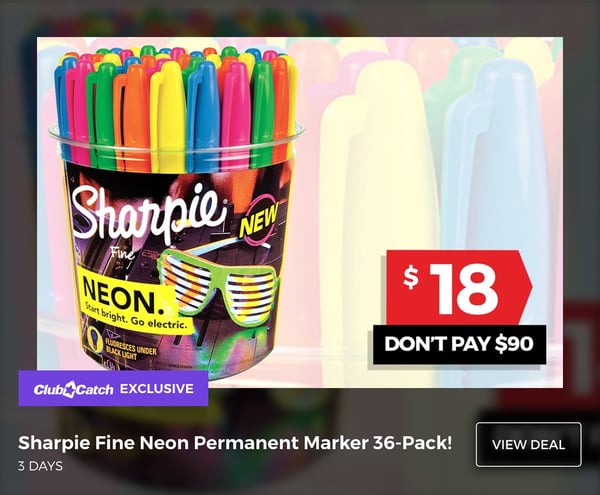
Club Catch has its own dedicated page to let non-members see what they are missing out on:
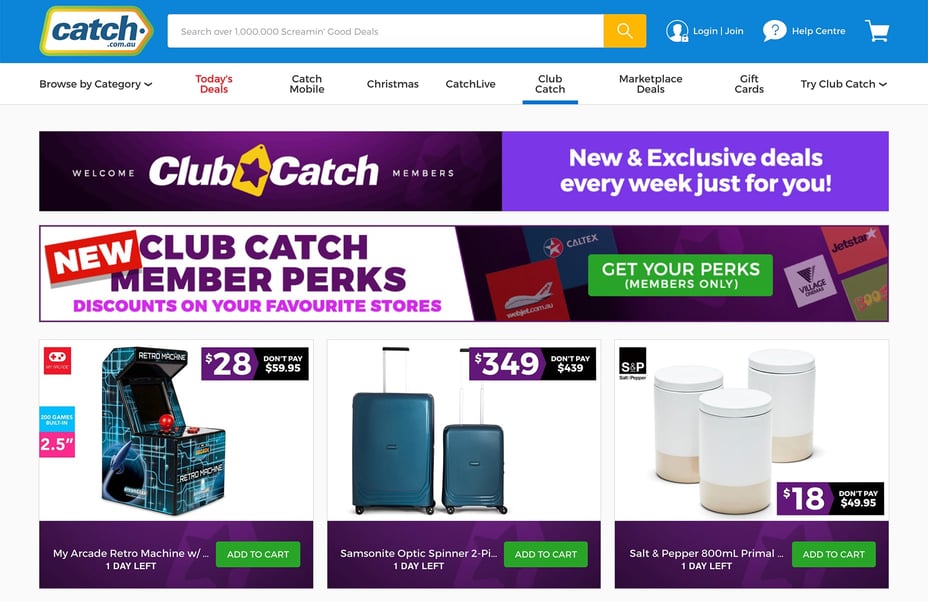
Club Catch is heavily promoted across the entire shopping experience.

Particularly on product pages:

And also in the shopping cart:
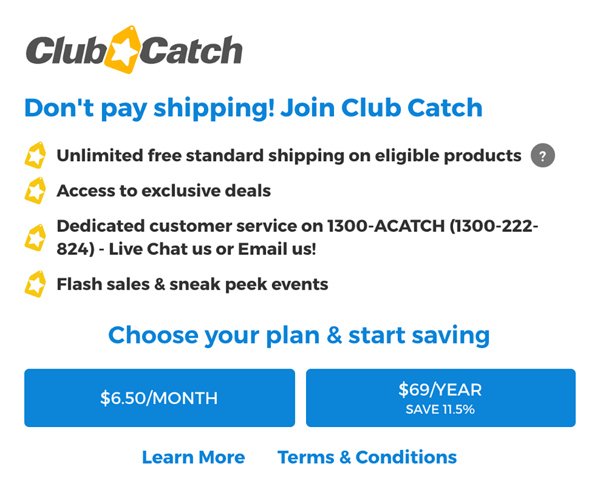
They understand that free shipping is a big selling point for driving sales and use this as leverage to sell an additional product.
If you look at the product pages they position the call to action as a question – I want free shipping and more with Club Catch
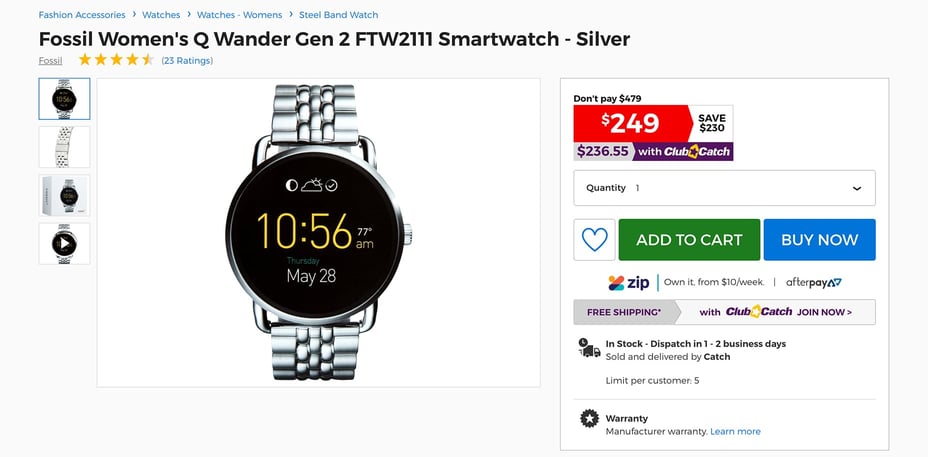
After you click on Try Club Catch, you get taken to a dedicated landing page that gives you an overview of all the possible benefits before joining.
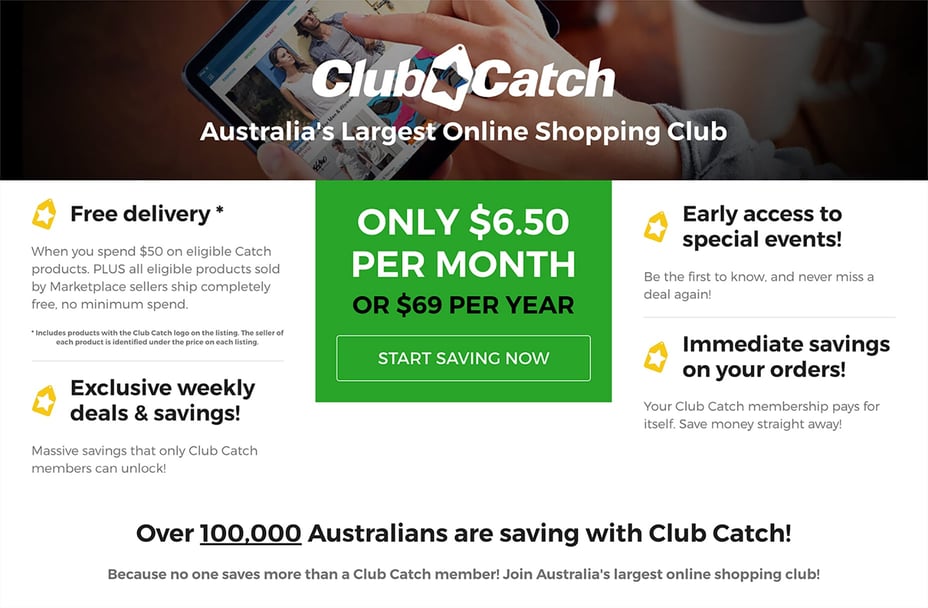
Creating a membership program is a great way to increase the loyalty, average order value and lifetime value of customers.
Membership programs appeal to customers by creating a feeling of exclusivity.
If you do implement a membership program some of the important things you need to consider are:
- Membership benefits: Think of aspects that will entice your customers to join your program. What will they get out of the program? Besides additional sales and events, one of the main benefits of Club Catch offered was free shipping.
- Pricing: You’ll need to consider the costs of joining the membership program and whether it will be a single payment or on-going (monthly, annually etc.).
- Promotion: Where are areas on your site you can persuade customers to try the program?. You’ll also need to plan out your CTAs to make them effective. If you don’t allocate resources to create specific ongoing benefits you might lose members.
However, if you’re just starting out then it’s probably best to wait until you build a loyal customer base before starting a membership program.
Naturally, the exception applies if your business is solely based on the membership model, e.g. Dollar Shave Club.
Checkout
The check out process is relatively easy and quick from adding items to the cart to payment.

The entire process takes two steps over 2 pages allowing customers to complete everything quickly. The Shopping Cart screen is simple, clear and intuitive.
This allows you to quickly identify all the information you need to evaluate and complete your purchase.
There aren’t any distractions on the page other than the prompt to signup for Club Catch.Catch.
After clicking that, a pop up appears allowing you can learn more and even sign up without leaving the checkout page (as we mentioned earlier for the signup modal). Catch uses this technique to avoid losing customers at vital points in the purchase cycle.
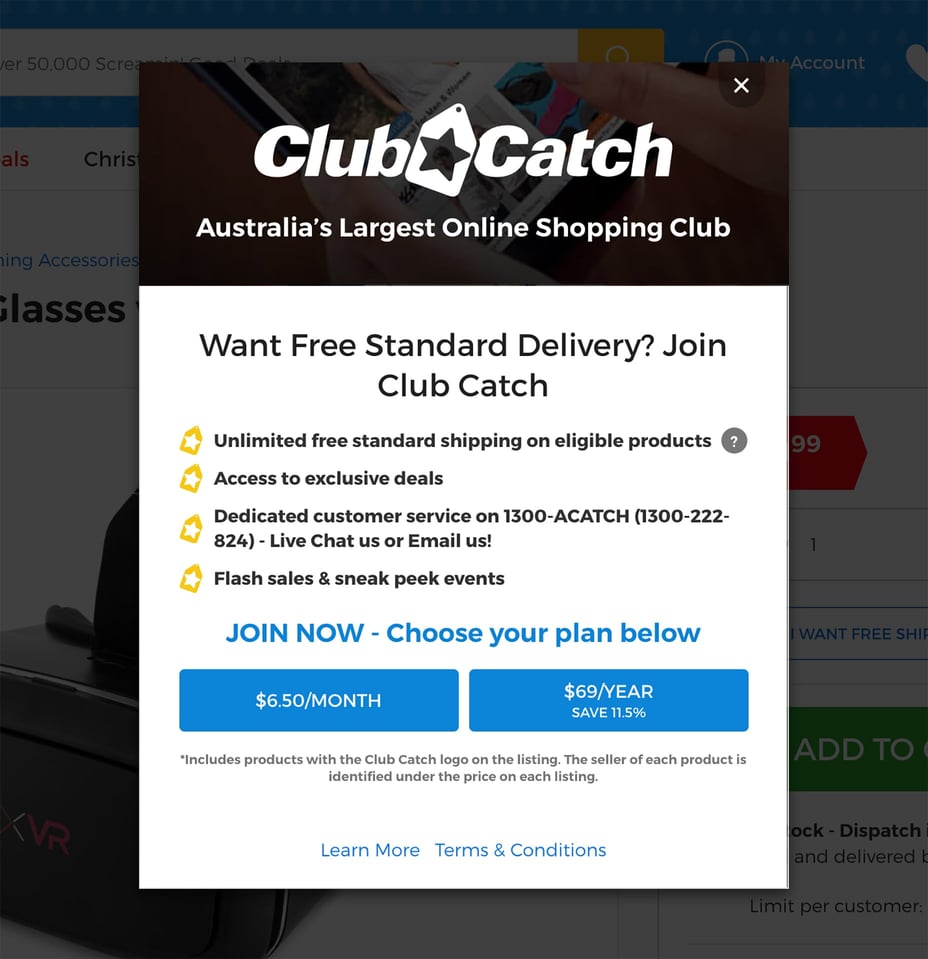
Editing items in your cart are easy and convenient. You can change purchase quantities, remove items or even change clothing sizes without leaving the page.
The payment button is clear and creates a sense of security with the customer with their green call to action, Pay Securely Now.
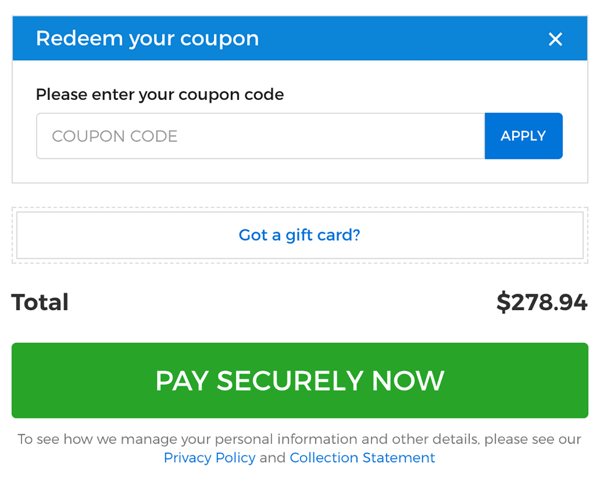
Catch requires new customers to create an account before payment, this also signs users up to their daily deals.
On the payment page, Catch uses urgency to prevent shopping cart abandonment and prompt customers to pay quickly with a message saying that stock isn’t reserved until you complete payment.

Catch gives shoppers a range of payment options, such as Credit Card, Paypal & zipPay.
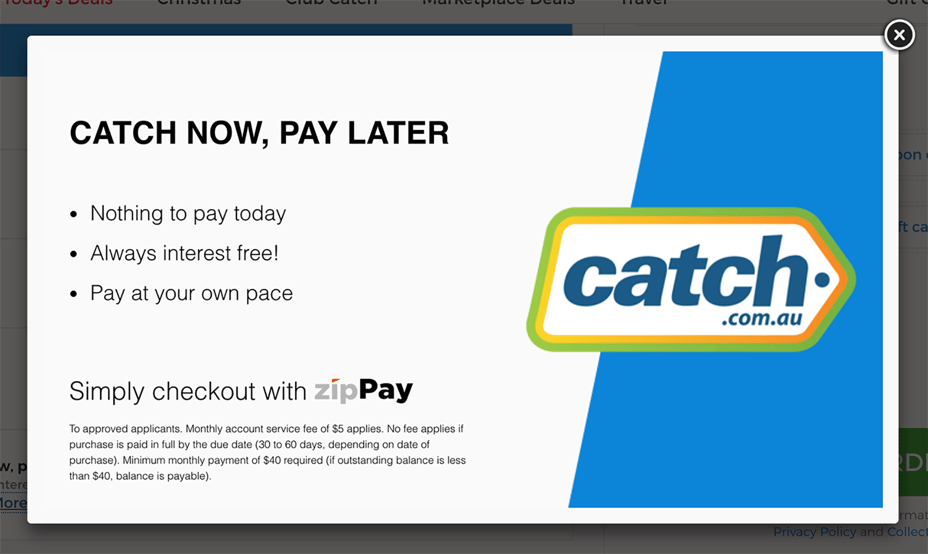
The checkout process is where you don’t want to lose your customers. Some triggers that stop customers from completing the process includes checkout being too long, hidden costs and security issues.
Catch has to deal with the fact that they also supply items via 3rd party sellers. They address this by splitting out these items in the Shopping Cart:

As a result, it is important to optimise your checkout process to be quick, secure and easy to use, with all information displayed clearly.
Here are some tips to achieve this on your own E-Commerce site:
- Clear away clutter: Make sure that your cart summary just shows the information that is significant to the customer, e.g. total cost and shipping charges. Remove anything else that may distract them (i.e. navigation) from going to the payment stage or leaving the page.
- Provide customer security: Giving customers a sense of security in the checkout process builds trust. You could implement a live customer support widget, like what Catch has done, show that the site has a security verification or has an SSL certificate.
- Optimise and test your call to actions (CTA): Adding colours to your call to actions, make your page visually appealing, attracts the viewer’s attention and also makes it easier for customers to know where to click. Choose colours that are in line with your brand image and continually do testing.
- Keep customers on the checkout page: Don’t divert them away from the page once customers are in the checkout phase. But If you want to upsell or recommend suggested products, you could follow Catch and add it as a modal.
Social Media
Catch operates across a number of social channels such as Facebook and Instagram. Their most active and effective channel is Facebook with over 530,000 followers.
However they don’t seem to be that active on these channels, perhaps that’s because they don’t drive enough ROI or value?
Catch uses Facebook mainly for posting the latest sales, shopping events and daily deals.
They also use humour, emojis and images of products they want to showcase. They portray themselves as being fun and spontaneous through the copy on their posts.
They also occasionally share content from other popular Facebook pages, such as Unilad, that’s related to their sale to boost engagement.
Catch also uses Facebook to boost engagement through live streaming, running competitions and showing videos of staff demonstrating products that are on sale.
Facebook has helped Catch increase sales of its daily deals and products. The sharing mechanism allows their offers to spread throughout friends timelines – which in turn drives more awareness and sales.
In 2013 Catch mentioned that they were getting over 700+ orders a day through Facebook. However it’s unclear if they are still driving this much engagement or not.
Even though they have 580k followers, many of their posts are getting less than 25 users engaging with them. So it seems that Catch really suffers from Organic Reach problems (much like the rest of us).
Video, on the other hand, does seem to drive a lot more views and engagement. This one below had over 300k+ views.
Out of Catch’s social media profiles, Twitter has the lowest number of followers. While they have a high following of 27k+ followers on Catch’s Twitter page, there is little to no engagement on posts.
Content and copy on are identical to posts on Facebook. Additionally, Twitter isn’t very active, with the most recent post from September 22.
Perhaps they didn’t see the ROI in pursuing Twitter as a channel?
Over on Instagram, Catch has 5k+ followers and their profile is actively maintained. Content posted here is much more visual and contains photos of products and brands with a mixture of promotional posts thrown in.
Looking at how Catch approaches social media, it’s clear that they lack overall vision and execution on this channel.
- No unified approach on what to post on each channel
- Their posts feel more just like announcements
In part this is perhaps a byproduct of their business model and the fact that their deals are for small finite periods. Therefore it can be hard to have a consistent brand identity or theme across each network.
Competitions
Catch understands the importance of using Competitions to build buzz and drive awareness for various initiatives and sales.
The types of campaigns they run fall into two main categories:
User Generated Content
Catch likes to run competitions that have the ability to generate a lot of brand buzz by getting users to submit content.
If you look on Facebook, any of their contests posts are by far the posts that have the most views and engagement.
In their most recent competition, they asked participants creating their own version of Catch’s Screeaaamin deals TV commercial to win a share of $15,000 in cash and prizes. Entries were uploaded via a dedicated landing page on the Catch.com.au website.
Catch cleverly uses the winner notification process as a way to leverage more exposure. Instead of privately contacting competition winners, they show the winning entries on social channels.
For the most recent competition, they posted a daily video from each winner on their Facebook page. Notice how they link to the ongoing Competition in that post also? This gives them the chance to continually promote the campaign to new viewers too.
Product Focused
Another type of Competition that they run focused on specific products or brand events that are running.
When the new Nintendo Mini NES was launched they ran a campaign to build buzz:
Or they also ran a simple Facebook Page based campaign to promote sales of this Alpha 1 Humanoid Bot:
If you’re interested in running your own campaigns like this, check out this example built using Gleam:
Also check out some of our guides on how to get started here:
- How to Run a Facebook Contest
- How to Run an Instagram Contest
- Top Mistakes Businesses Make With Their Contests
- How to Run a User Generate Content Contest
So there you have it, some techniques that helped Catch Group increase their sales and become one of the top E-commerce brands in Australia.
Let us know in the comments if any of these tips helped you grow your own business and anything else you think could help our readers 😎
